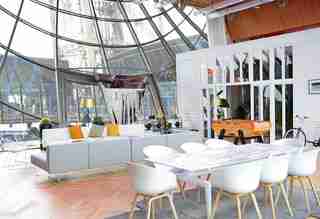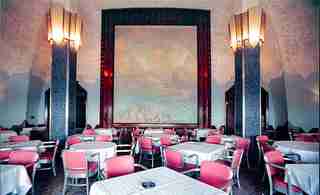8 Hidden Spaces Inside the World’s Most Famous Architecture
Discovering something new about something, well, old is perhaps one of the greatest joys of architectural history. Trap doors, hidden rooms, secret bars...uncovering the latent lives of great buildings is a tantalizing game for which there exists no shortage of subjects. Take New York ’s Grand Central Terminal, whose “secrets” are plentiful: Accessible via a shared elevator, there’s both the now-famous (and closed for renovations) Campbell Apartment bar, the beloved clubby interiors of which went unchanged for decades, and the Vanderbilt tennis club, a favorite haunt for well-heeled Manhattanites to don their tennis whites. In cities around the world, from Paris to Rome to London and beyond, similar treasures await discovery.

Apartment, Eiffel Tower, Paris
Many know that Gustav Eiffel added a secret apartment for himself to his design of Paris’s most famous landmark. But just last year, HomeAway did Monsieur Eiffel one better, nestling a temporary rental apartment some 147 feet high within the tower.

Vanderbilt Tennis and Fitness Club, Grand Central Terminal, New York
Opened in 2010, the Vanderbilt tennis club occupies a corner of Grand Central that’s held a rather unusual array of functions, among them a CBS recording studio and art gallery.

Cloud Club, Chrysler Building, New York
Though it shuttered in the 1980s, the Chrysler Building’s glamorous Cloud Club catered to the midtown magnates of the time. The space was sadly gutted for offices in the following decades.
Congressional Bunker, Greenbrier Hotel, West Virginia
Hidden in the basement of the historic Greenbrier hotel in Sulphur Springs, West Virginia, is a Cold War-era congressional bunker built 1958 to hide members of congress in the event of a national emergency.
Ons' Lieve Heer op Solder, Amsterdam
Fearing religious persecution in 1663, Amsterdam’s catholic contingent concealed a magnificent space of worship in the attic of a quintessential Dutch canal house. Today, the space is open to the public as a museum.
Hall of Records, Mount Rushmore, Keystone, South Dakota
Carved into the stone behind the iconic busts of Mount Rushmore lies a little known room whose initial purpose was to serve as a Hall of Records for the national monument. After its construction halted in 1939, the room was left largely untouched until 1998, when a box of records, an ode to its designer Gutzon Borglum, was placed inside.
Le Showcase, underneath the Pont Alexandre III, Paris
On the Right Bank of Paris’ famously ornamented Pont Alexandre III exists a concealed staircase that leads adventurous nightlife seekers to Le Showcase , a cavernous stone nightclub nestled underneath the bridge.
Operating Theater, St. Thomas's Church, London
Discovered in 1957, the operating theater at London’s St. Thomas’ church is the oldest of its kind—a space where medical students would watch and learn from live procedures—and is dated back to the church’s construction in 1822.